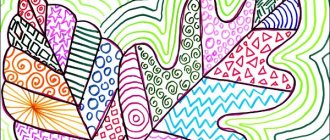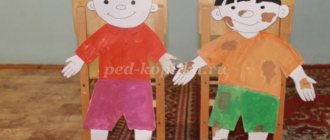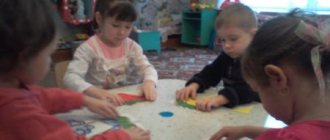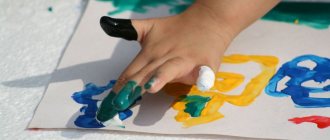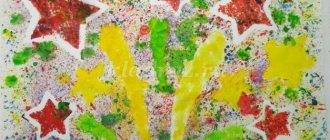Drawing lesson in the first junior group Topic: “Let’s decorate the tumbler”
Municipal preschool educational budgetary institution
"Kindergarten No. 4 of a combined type" Volkhov
Drawing class
in the first junior group
Topic: “Let’s decorate the tumbler”
Educator:
Ryabova I. Yu
Goal: to form in children an idea of the tumbler toy.
Tasks:
- teach children to decorate the silhouette of a tumbler with rhythmic strokes;
- arouse interest in reviving the applique image, in the search for visual and expressive means;
- cultivate a sense of color and shape.
Preliminary work:
Looking at tumblers of different sizes.
Clarification of the understanding of the meaning of the word “tumbler - a doll that does not fall, does not roll, does not lie down.”
Examination of the shape of a tumbler toy.
Modeling tumblers on the street from snow.
Comparison of tumblers with matryoshka.
Materials:
Sheets of white paper with silhouettes of tumblers pasted on by children, cotton swabs, brushes, paper and cloth napkins, paints, jars of water.
Progress lesson
We look at the tumbler and read an excerpt of the text of a Norwegian song:
- Dance, my doll
Dance more fun
Dance more fun
Don't be sorry for your heels.
- Guys, who is this?
Children's answers tumbler
- That's right guys! Why is she called that? (she doesn’t lie down, doesn’t roll around, but gets back up).
- The tumbler's body is round and its head is round. What shape is the body, what shape is the head?
Children's answers: round
- Guys, look at your tumblers. What do they lack?
Children's answers
- That's right, guys, they don't have any eyes, nose, or mouth. Let's draw the tumbler's face.
Children's answers
To do this, we will take a cotton swab, dip it in black paint and apply it to the face. It turned out to be an eye and another one. Then turn the stick with the other end and dip it in red paint. Let's draw a mouth.
Children draw
- These are the funny tumblers we got.
While the tumbler's face is drying up, a didactic game: “decorate the tumbler's dress.”
A tumbler is laid out on a flannelgraph; we invite children to decorate her dress with white peas.
- Now look, guys, our tumbler turned out to be ugly, let’s decorate her dress.
We take a brush, dip it in white paint and apply the entire pile to the dress. You can also decorate the dress with short lines, they can be arranged from top to bottom, or from left to right (teacher demonstration). To make peas, you need to dip the brush in the paint, apply the tip of the brush to the dress and remove it. These are the tumblers I got. After work, they form a round dance, and at this time we dance the dance: “We are cuties, tumbler dolls.” After the dance we look at our drawings.
Summary of a drawing lesson on the topic: “Favorite toys”
E koši kiši
to byndagy ұyimdastyrylgan oku kyzmetіnіn notes
Summary of organized educational activities in the second junior group
Lesson/Date:
1. 03.19
Tarbieshi/Teacher: Ospanova A.M.
Bilim take salas/Educational field: “Creativity”
Pәn/Subject: “Drawing”
otpeli takyryp / Cross-cutting theme: “In the world of the incredible”
Takyryby/Topic: “ Favorite toys ”
Maksattaras/Goals:
1. Tarbielik - educational:
instill in children a caring attitude towards toys
;
cultivate interest in artistic creativity.
2. Damytushylyk developing:
Develop creative perception and imagination,
develop aesthetic feelings, develop memory, attention, accuracy;
3.Okytu - training
:
Teach the ability to draw and paint over a picture, arrange it beautifully on a sheet of paper, strengthen the ability to hold a brush correctly; learn to guess riddles;
Pedagogical technology / pedagogical technology::
health-saving, personality-oriented, information and communication
Resource kamtamasyz etu / Resource provision:
card index of riddles, exhibition of toys.
Bil ingvaldik component /
Bilingual component : toy - oyishyk, favorite toy - suyikti oyynshyk
Ұyimdastyrylgan oku kyzmetіnіn barysy/ Progress of the lesson:
I .Ұымдастырушылқ кезңі/organizational moment
1.Reading a poem:
Our toys are good: Dolls, bears and firecrackers, It’s fun to play with them, But we must not forget: Toys are not people, But everyone understands And they really don’t like it when they break them. Let the toys be friends with us, We won’t offend them, Let’s play and then put everything back in its place. (Z. Petrova)
II . Negіzi bolіmі/main part .
— Guys, tell me what this poem is about?
— Where do toys come from at home, in kindergarten?
—
Yes, but first they are made in a toy factory, only then do they get to the store where they are bought. I want to invite you to the toy store to add them to our group. And in order to purchase them, you need to pay not money, but solve riddles about the toys.
2. Asking riddles:
1.Wooden girlfriends.
They dance on the top of his head,
They beat him, and he thunders,
He orders everyone to keep pace. (Drum).
2. She doesn’t need a driver at all. You turn it on with the key - the wheels will start spinning, put it in, and it will rush off. (Wind-up machine)
3. The beloved animal is all made of plush: Paws, tail, even ears. (Teddy bear)
4. Gray flannelette animal,
Cross-eyed - long-eared.
Well guess who he is
And give him a carrot! (Bunny).
Imagine that you will now become master artists, I suggest you now draw your favorite toys.
Sozdik zhumys/ Vocabulary work :
Explanation of the meaning of new words, illustrations.
Bilingual component /
Bilingual component : toy - oyishyk, favorite toy - suyikti oyynshyk
3. Display of work.
4. Explanation of safety rules.
5. Finger gymnastics
.
I play with toys: (Hands in front of you, clench and unclench the fingers of both hands.)
I throw the ball to you, (We stretch our arms forward - “throw the ball.”)
I assemble the pyramid (we place straight hands, palms down, on top of each other several times.)
I drive the truck everywhere. (We move the slightly open hand of our right hand in front of us - “roll the car.”)
6. Independent work of children.
7. Exhibition of works.
You have made wonderful toys, they can be placed in our exhibition.
III . Korytyndy/final part
Analysis of the work of organized educational activities
-What did we talk about today?
-What did you like?
— What do you remember?
E koši kiši
to byndagy ұyimdastyrylgan oku kyzmetіnіn notes
Summary of organized educational activities in the second junior group
Otkizu kuni/Date:
1. 03.19
Tarbieshi/Teacher: Esmaganbetova G.A.
Bilim take salas/Educational field: “Creativity”
Pәn/Subject: “Drawing”
otpeli takyryp / Cross-cutting theme: “In the world of the incredible”
Takyryby/Topic: “ Favorite toys ”
Maksattaras/Goals:
1. Tarbielik - educational:
instill in children a caring attitude towards toys
;
cultivate interest in artistic creativity.
2. Damytushylyk developing:
Develop creative perception and imagination,
develop aesthetic feelings, develop memory, attention, accuracy;
3.Okytu - training
:
Teach the ability to draw and paint over a picture, arrange it beautifully on a sheet of paper, strengthen the ability to hold a brush correctly; learn to guess riddles;
Pedagogical technology / pedagogical technology::
health-saving, personality-oriented, information and communication
Resource kamtamasyz etu / Resource provision:
card index of riddles, exhibition of toys.
Bil ingvaldik component /
Bilingual component : toy - oyishyk, favorite toy - suyikti oyynshyk
Ұyimdastyrylgan oku kyzmetіnіn barysy/ Progress of the lesson:
I .Ұымдастырушылқ кезңі/organizational moment
1.Reading a poem:
Our toys are good: Dolls, bears and firecrackers, It’s fun to play with them, But we must not forget: Toys are not people, But everyone understands And they really don’t like it when they break them. Let the toys be friends with us, We won’t offend them, Let’s play and then put everything back in its place. (Z. Petrova)
II . Negіzi bolіmі/main part .
— Guys, tell me what this poem is about?
— Where do toys come from at home, in kindergarten?
—
Yes, but first they are made in a toy factory, only then do they get to the store where they are bought. I want to invite you to the toy store to add them to our group. And in order to purchase them, you need to pay not money, but solve riddles about the toys.
2. Asking riddles:
1.Wooden girlfriends.
They dance on the top of his head,
They beat him, and he thunders,
He orders everyone to keep pace. (Drum).
2. She doesn’t need a driver at all. You turn it on with the key - the wheels will start spinning, put it in, and it will rush off. (Wind-up machine)
3. The beloved animal is all made of plush: Paws, tail, even ears. (Teddy bear)
4. Gray flannelette animal,
Cross-eyed - long-eared.
Well guess who he is
And give him a carrot! (Bunny).
Imagine that you will now become master artists, I suggest you now draw your favorite toys.
Sozdik zhumys/ Vocabulary work :
Explanation of the meaning of new words, illustrations (slide presentation).
Bilingual component /
Bilingual component : toy - oyishyk, favorite toy - suyikti oyynshyk
3. Display of work.
4. Explanation of safety rules.
5. Finger gymnastics
.
I play with toys: (Hands in front of you, clench and unclench the fingers of both hands.)
I throw the ball to you, (We stretch our arms forward - “throw the ball.”)
I assemble the pyramid (we place straight hands, palms down, on top of each other several times.)
I drive the truck everywhere. (We move the slightly open hand of our right hand in front of us - “roll the car.”)
6. Independent work of children.
7. Exhibition of works.
You have made wonderful toys, they can be placed in our exhibition.
III . Korytyndy/final part
Analysis of the work of organized educational activities
-What did we talk about today?
-What did you like?
— What do you remember?
On the topic: methodological developments, presentations and notes
Goals: to introduce children to objects in their immediate environment - toys; learn to answer questions, describe a toy and actions with it, carry out simple tasks, compare and distinguish plastic ones, p.
Goal: · To teach children to use words-names to perceive the qualities of an object. · To improve the level.
"A fun journey on a train."
Lesson 3Purpose. Develop interest and respect for theatrical dolls, create a desire to play with them, and the ability to focus your attention on the toy. Maintain the desire to listen to poetry, answer.
Lesson summary for older children. Topic: “Dymkovo toys” Goal: Introducing children to folk culture through familiarization with the Dymkovo toy. Objectives: - To cultivate love and respect.
Maslenitsa is a wonderful, bright and joyful holiday of seeing off winter and welcoming spring. This is a traditional Russian folk holiday: cheerful, noisy, mischievous and very tasty. Every preschooler in our village...
Source
On the topic: methodological developments, presentations and notes
Abstract of GCD in the 2nd group of early age, direction "Artistic and aesthetic development. Modeling." Topic: Nuts for the squirrel.
Summary of educational activities in the 2nd group of early age. Direction Artistic and aesthetic development. Application. Topic: “Autumn leaves.”
Topics, tasks, equipment for art classes for young children.
Summary of a lesson for children of the younger group on miraculous aesthetic development (modeling) “Let's decorate a cup.”
Summary of an educational activity for young children on artistic and aesthetic development (growing) “Rays for the sun.”
Topic: "Drawing a fairy tale."
laquo;The origins of children’s abilities and talents are at their fingertips. From the fingers, figuratively speaking, come the finest threads - streams that feed the source of creative thought. In other words.
Source
Goals:
Enrich children's active vocabulary with words-names of toys. Form stable ideas about size, shape, color, quantity. Continue to introduce children to geometric shapes. Teach children to make a whole from parts. Introduce children to an unconventional drawing technique - drawing with cotton swabs. Improve the ability to draw straight lines with a pencil, paste image details in the right place. Develop thinking, fine and gross motor skills. Practice onomatopoeia, the ability to navigate in space, and coordinate movements with words. Improve concentration and attention span. Cultivate a caring attitude towards toys.
Equipment:
Toys: Cheburashka, small distributing dolls, cubes, balls, cat, bear, flags, steering wheels. A picture of Cheburashka without ears and a bib, these parts cut out of paper, glue sticks. A sheet of green cardboard with a river, narrow and wide bridges, bushes with three and many berries glued on. Cotton swabs, red gouache, baskets cut out of paper. Pictures with a silhouette image of a tumbler (made of circles), multi-colored circles corresponding to the size of the picture, multi-colored pebbles, a circle with the image of a tumbler’s face. Clothespins, colorful circles. Drawing with empty spaces in the form of geometric shapes, geometric shapes of appropriate sizes and colors. Cut-out pictures depicting toys. Cookie squares cut out of cardboard, pictures depicting a cat, dog, cow, mouse, crow, pig, goat, duck, chicken. Colored pictures of toys cut out of paper and their black shadows drawn on cardboard. Colored pencils, sheets of paper with drawn flags without sticks. Audio recordings: “Cheburashka”; “Flag”, “Animal Toys” by Zheleznova.
PROGRESS OF THE CLASS:
Greeting "Everyone clapped their hands"
Everyone clapped their hands, together, more fun! Our feet started pounding, louder and faster! We'll hit you on the knees. Hush, hush, hush. We raise our hands, our hands, higher, higher, higher! Our hands began to spin. They went down again. They spun, spun and stopped,
Surprise moment "Cheburashka"
Look who came to visit us today? Cheburashka. He is a toy himself and loves other toys. Today we will play with a variety of toys.
Application "Cheburashka"
To complete the portrait of Cheburashka, you need to glue on the missing parts: ears and bib.
Didactic game “Matryoshka dolls went to the forest”
Matryoshka dolls love to go for walks in the forest. Now take the matryoshka doll and take it for a walk. (Children manipulate a matryoshka toy on a sheet with glued bridges across a river, tree stumps, and berry bushes).
Here comes the nesting doll. And in front of her is a river. Are there bridges? How many bridges? Two bridges. Identical bridges? No. Various bridges. One bridge is narrow and the other is wide. The nesting doll walked along the narrow bridge. She got tired and sat down to rest on a narrow stump. Uncomfortable on a narrow stump, the nesting doll moved to a wide stump. And here are the bushes with berries. There are many berries on one bush. And on the other there is little. The matryoshka approached a bush with few berries. She collected all the berries and counted them: one, two, three. Then the nesting doll went to a bush with a lot of berries. It's time for the matryoshka to go home. She walked home along the wide bridge. Goodbye!
